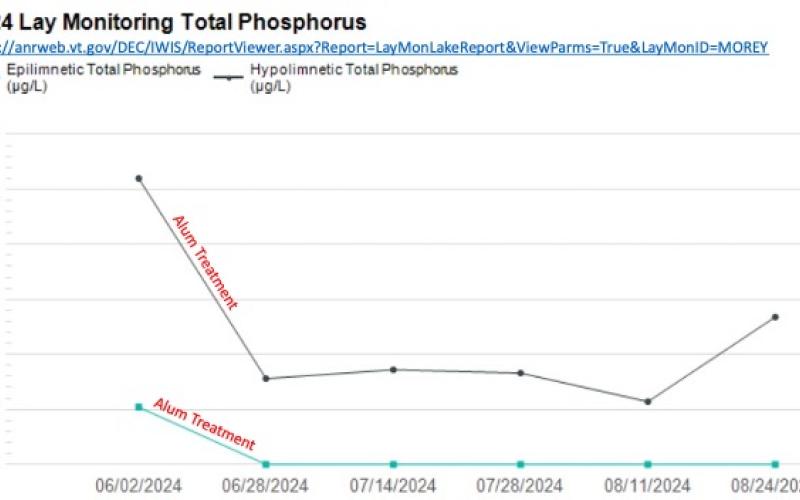
Lake Morey Water Quality Improves After Alum Treatment in June 2024
Nestled among hills in the town of Fairlee, Lake Morey is one of Vermont’s jewels. This 550-acre lake is a popular destination for anglers, birders, boaters, and campers.
During August–October of 2022, Lake Morey’s summer recreational season was cut short by an intense, prolonged cyanobacteria bloom. Cyanobacteria, also called blue-green algae, are photosynthetic bacteria that grow like algae naturally in lakes, but in phosphorus-rich waters they can form blooms that can be toxic to humans and other wildlife. Although the residents around Lake Morey are working hard to minimize phosphorus inputs from the shoreland and watershed, there is legacy phosphorus in the lake bottom sediments that releases during summer (known as internal loading). The persistence of cyanobacteria blooms along with volunteer lake sampling coordinated by Mark Mitchell from Lake Champlain Sea Grant led to the lake being listed as Impaired for Aesthetics Use based on Lay Monitoring Program phosphorus data from 2013-2022 under Vermont Water Quality Standards.
This is not a new issue for Lake Morey. In the 1970's and early 1980's cyanobacteria blooms also "severely interfered with recreational use of the lake," prompting a diagnostic-feasibility study completed in 1984. The study led to a successful alum treatment in 1986 to control internal phosphorus loading from the lake sediments. When alum (aluminum sulfate) is added to a lake, phosphate is removed in the water column through precipitation forming a floc that settles to the lake bottom. This floc layer forms a barrier to internal phosphorus loading from the sediment.
Nearly 40 years later, a new sediment study was completed in January 2023 that recommended another alum treatment, which was then permitted and funded by the Vermont Department of Environmental Conservation (VTDEC) and completed in June of 2024 in collaboration with the Town of Fairlee. The alum treatment was once again successful at reducing phosphorus from internal loading and in the water column to well below the water quality standard, which resulted in very low chlorophyll-a (algae) and very high Secchi transparency (clarity). The effectiveness of the alum treatment is expected to last up to 40 years based on the previous results.
Continued lake and tributary water quality sampling under the Lay Monitoring Program has led to VT DEC funding a Lake Watershed Action Plan (LWAP) that was initiated in 2022 and completed in 2024. An LWAP is an assessment and planning tool used to identify how land uses (shoreline development, road networks, agriculture, forestry, etc.) are impacting the lake and it’s tributaries. Projects are then prioritized for addressing water quality concerns in a specific lake watershed. The White River Natural Resources Conservation District worked with Bear Creek Environmental to develop the Lake Morey Watershed Action Plan in collaboration with project partners including the Lake Morey Protective Association, the Lake Morey Foundation, the Lake Morey Commission, and private landowners. The prioritized list of restoration and protection projects identified through the LWAP process can be considered for funding under the Clean Water Initiative Program (CWIP) and other sources. Although the lake has seen a great improvement from the alum treatment, it’s critical to minimize land use impacts around impaired water bodies and have plans to do so through these LWAPs.
Heather Pembrook, former Deputy Commissioner of the Vermont Department of Environmental Conservation (DEC), attended the Lake Morey Protective Association annual meeting in 2024 and wrote, “They were so appreciative of the years of monitoring, education and assistance provided…They are thrilled with the in-lake results, and [Lake Champlain Sea Grant’s] work reflects well upon DEC and the State.” The Town of Fairlee wrote, “Within days lake residents were commenting on the effectiveness of the [alum] treatment.” See 2024 volunteer phosphorus monitoring results in the 2024 Lay Monitoring graph.